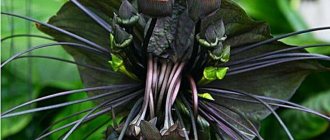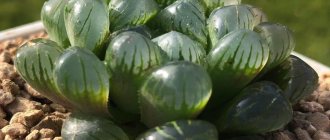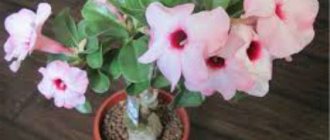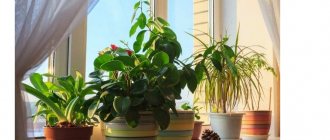There are flowers with a heavy and specific aroma that causes migraines. There are plants that should not be kept at home, as they can cause severe poisoning. From time immemorial, folk signs have come down to us, conveying to us the knowledge of our ancestors about which flower can negatively affect our feelings and emotions, cause disputes and problems in the family. Let's tell you more about them.
What flowers should not be kept at home and why: photo
When buying another beautiful flower in the store, we often don’t even suspect that it can have a negative effect on our well-being. It is especially important to choose the right house plants if you have small children or pets. So, let's figure out which plants you need to be extremely careful with.
Poisonous house flowers
This category includes plants that cannot be kept in the house due to their dangerous properties. If for some reason these flowers are on your windowsill, be very careful. It is necessary to wash tools thoroughly, protect your hands with gloves when caring for flowers and place them away from the food preparation area.
Spurge. A plant that resembles a cactus, it cannot be planted at home because an accidental prick on a milkweed needle sometimes leads to serious consequences.
Euphorbia secretes whitish juice; this liquid, upon contact with the skin or mucous membranes, causes vomiting, problems with stool and fever.
Dieffenbachia. An attractive plant with yellowish leaves, loved by housewives. But it must be remembered that this flower, even with a small cut, can release a toxic liquid. To avoid possible troubles, Dieffenbachia should not be kept at home.
If such juice gets on the skin, it causes a burn, and the result of contact with the mucous membrane is serious poisoning.
Indian Azalea comes with white, reddish and yellow flowers. If azalea leaves are ingested, it will cause severe intestinal upset.
Oleander. It has velvety pink flowers, due to which it often ends up in the house of housewives who do not suspect that the plant is extremely dangerous. In addition, during flowering, the smell of this plant makes you dizzy and migraines begin.
When in contact with human mucous membranes, oleander juice causes temporary or permanent blindness.
Evergreen ivy. The leaves and berries of ivy are poisonous, so this plant cannot be kept in an apartment; your beloved pet can be poisoned and even die.
A small shrub similar to vines, it is especially loved by representatives of the cat family.
Allergenic plants
There is a whole class of house plants that do not cause much harm to the human body, but can provoke allergies. Here is a selection of the most popular house flowers from this category.
Ficus. It would seem a completely harmless plant. And this is only half true; ficus very often causes allergic reactions in sensitive people.
Hydrangea cannot be grown at home if you are prone to allergies.
Primrose. When the flowering period begins, primrose begins to release toxins into the air, which often cause general malaise and nausea.
Allergy sufferers should not touch the leaves of the plant.
Potted flowers with a strong scent
These are harmless plants in themselves, but if they are kept indoors, they begin to emit a strong odor, which can lead to migraines and general loss of energy.
Lily. One of the most common flowers, which is often chosen as a gift for women. Lilies have a specific aroma, so they should absolutely not be kept where you sleep.
Flowers fill the room with carbon dioxide, resulting in hypoxia and headaches.
Fern. It affects the body in much the same way as lily.
Orchid. A beautiful and tall plant with a variety of shades of flowers. The orchid has a stimulating effect on the nervous system, so place a pot with it in the work area.
Tuberose. It has a heavy and memorable smell. The plant fills the air with microparticles that provoke weakness and depressive moods.
It has a negative effect on heart patients and hypertensive patients, causing them to become apathetic.
Houseplants with negative energy
All plants are living and each of them has its own energy. In addition, they can have a positive or negative impact depending on where they are located. Sometimes, for inexplicable reasons, the house becomes uncomfortable. Our green friends are often the cause of a changing energy climate.
Monstera. In a house where monstera grows, serious quarrels can arise over any trifle.
Moreover, the more beautiful the flower itself, the more difficult the situation in the family.
Mimosa is bashful. They call it shy because when you touch the leaves, they curl up. However, it also cannot be kept in the room; the flower fills the air with toxins that lead to baldness.
It is believed that mimosa brings despondency and melancholy to household members.
Trichocereus. A type of cactus that contains toxins. These substances cause hallucinations.
Trichocereus sucks energy from household members.
Indoor roses. They require special treatment and take all the energy from their family.
To avoid feeling exhausted, you need to limit the number of rose bushes at home or completely abandon them.
This is a selection of the most commonly found flowers in our homes; when buying a new unfamiliar plant, be sure to find out about its basic properties in order to avoid problems in the future.
Names of dangerous varieties with photos
You need to know the enemy by sight - therefore, this article presents particularly dangerous species with accompanying photos. Among them, it is easy to recognize the very popular varieties in floriculture, which are found in almost every apartment and office.
The following parts of these flora representatives are dangerous:
- flowers;
- fruit;
- seeds;
- leaves;
- juice;
- stems.
That is why they must be positioned in such a way that no one touches them, even by accident.
For man
All of the above species pose a danger to humans. However, the list of harmful plants is very long, so it is worth paying attention to several more representatives:
- Barringtonia. This unusual flower has poisonous leaves (if ingested).
- Euonymus. Bright and attractive fruits, which, unfortunately, are poisonous, have a beautiful shape.
- Gloriosa. A very colorful herbaceous plant with poisonous sap.
- Yucca. It is not poisonous in itself, but the sharp edges of the leaves can cause injury, especially for the delicate skin of children.
- Oleander. A particularly dangerous representative of indoor flora, since even ordinary tactile contact can cause poisoning.
For animals
Animals, which, in general, are wild by nature and are accustomed to plant foods, can taste some indoor flowers. This sometimes even leads to the death of pets.
An animal can be poisoned not only by flowers from a pot, but also by a bouquet from a vase. Therefore, the following varieties should not be in the access area of pets:
- Narcissus;
- snowdrop;
- Caladium;
- Philodendron;
- burdock;
- acacia;
- lupine;
- broom.
Important! The exact list of prohibited varieties must be selected based on the type of pet that lives in the apartment.
What flowers should you not keep at home according to signs?
You can believe in omens, or you can be skeptical about them. However, it should be remembered that most of them, through the centuries, convey to us the wisdom of their ancestors. Therefore, it is at least worth listening to these tips. So, let's look at what you can't plant at home, according to the precepts of our ancestors.
Popular wisdom tells us that ferns cannot be kept in the house, they suck out all the vitality from its inhabitants.
Fern is a kind of vampire, making the inhabitants of the house sedentary, lethargic and tired.
Cacti are also considered unfavorable for an apartment. Cacti are especially dangerous for men. The head of the family may begin to abuse alcohol. According to another belief, a girl in whose house cacti grow may never meet her lover.
It is generally accepted that cacti in general have a bad effect on relationships within the family.
Ficus has an exciting effect on the child, making him overly aggressive. Also, if you are planning to have children, refrain from purchasing this plant.
Mother-in-law's tongue, as they say, makes people lonely. This flower has a bad effect on female energy, to the point that women cannot have a child. This is why a pot with a plant is not placed in the bedroom.
It is believed that mother-in-law's tongue drives men away from home.
Palm tree is quite common in homes, but you need to weigh the pros and cons several times before buying it. Palm tree promotes discord and misfortune in family life.
It is better to place them in office premises and open areas.
Azalea
Beautiful to look at and deadly to taste - this is how this flower can be briefly described. Azalea looks very impressive on any windowsill, has abundant flowering and is easy to care for, but its leaves contain toxic substances. If they enter the digestive tract, they can even cause toxic shock! If you have curious pets in your apartment who are eager to pinch off a leaf or two from the plant, we recommend that you immediately throw the azalea in the trash - this way you will extend the life of your pet for many years.
What flowers can you keep at home: signs
According to folk beliefs, there are a number of plants that help create a good microclimate in the apartment.
Geranium produces essential oils that have a calming effect on the human nervous system. Can improve the body's metabolism.
Place pots of it in work areas.
The lemon tree promotes a surge of strength and success in business, energizes you.
Maranta helps you find the meaning of life and move towards your goal.
Promotes success at work.
The money tree brings material well-being to the house.
It is better to plant such a tree yourself by placing a few coins underground.
The myrtle tree improves family relationships, brings harmony and inspiration to people who have been married for a long time.
Bamboo can transform a negative microclimate at home into a positive one.
Which plants should you be wary of?
There are a number of flowers that can cause harm if the wrong location in the house is chosen for them. Bright orchids, hydrangeas and lilies that delight with their blooms excite the nervous system with their appearance. It is better to exclude such flowers from the sleeping area and relaxation areas.
Ferns emit carbon dioxide at night and have no place in the bedroom. Lily, geranium, oleander and tuberose have a strong aroma. Their fragrance can cause headaches and nausea.
Climbing flowers at home: signs
Various beliefs tell us that climbing plants have powerful masculine energy, and therefore repel men. They will always strive to go somewhere else, go on a business trip, or start getting sick.
It is not recommended to keep climbing flowers at home, as they worsen the psychological state of household members and can provoke depression, melancholy and depressed mood.
Since ancient times, ivies have been associated with the afterlife, so it is better to take them out into open spaces. Outside, climbing flowers, on the contrary, will protect the house and all its inhabitants.
In conclusion, it is worth noting that house plants are not always harmless. That is why, before purchasing a beautiful flower, it is worth learning about all sorts of pitfalls that are associated with it. Putting this information into practice will keep you and your loved ones healthy.
Begonia
Beautiful begonia can even be useful: the plant secretes antimicrobial substances. However, will they be safe for allergy sufferers and pets? Both of them can react to them in completely ambiguous ways. In addition, begonia contains oxalic acid salts, which can cause severe burns to the mouth. So it is better to replace this beautiful plant, for example, with roses.
Ficus
At first glance, ficus is a rather harmless and even boring plant, which is usually placed in impressive tubs in offices. Meanwhile, at night it insidiously absorbs oxygen, so proximity to a ficus is unacceptable in a small bedroom. Also, you should not place it in the nursery: who knows what such oxygen “greed” of the plant will lead to.
Fern
Various variations of ferns are quite often the basis of a winter garden: they are really very beautiful and can turn any room into a real enchanted forest! There is also an opinion that fern can protect a house from evil spirits and reconcile the people living in it. Unfortunately, all these magical properties will have to be abandoned if allergy sufferers live in the apartment.











